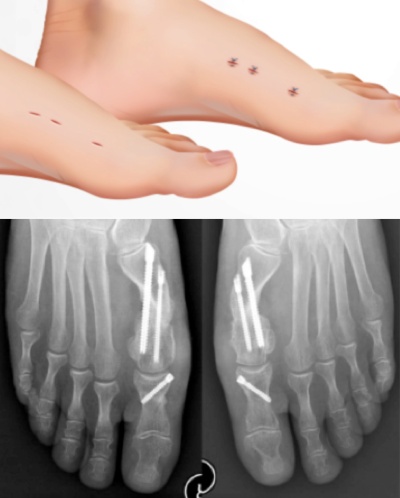If you have a painful bunion that has been present for several years and comfortable shoes are difficult to find, you may be a candidate for surgery. You should have stopped wearing high heels and narrow shoes prior to considering surgery. Cosmetic appearance is never a reason to consider surgery. Although the minimally-invasive surgery is often much more cosmetically pleasing than other methods, this is not the goal of surgery. Every surgery will leave scars, which could be painful. No surgery can guarantee there will not be a complication. Never have a painless bunion corrected.
Patients who are candidates for surgery are those with painful bunions who have failed all non-surgical measures such as wider shoes and anti-inflammatories. The bunion should be of moderate size without dislocation of the joint. There should be little or no arthritis. The patient should have their growth plates closed. This procedure is not for juvenile bunions which are much more likely to recur and often have open growth plates that could be damaged by this procedure. Anyone who has medical issues preventing anesthetic are not candidates for this surgery.

The minimally invasive bunion correction is an outpatient procedure. You will have a general anesthetic and local anesthetic will be injected around your toe during the procedure to help control pain after surgery. You will need a driver to drive you home.
The bunion will be corrected by what is called an “osteotomy”. This means that the bone will be cut, shifted into the correct position and then fixed in place with screws. Most bunions will require two cuts and three screws. The cutting tool is not a saw, but a specialized cutting burr which uses high torque and low speed with irrigation. It is designed to cut bone and not tendon, nerves, or arteries; however, as in any surgery, there is always the potential for injury to these structures.
Because the procedure is done with x-ray guidance and is much more technically difficult, it typically takes longer than a traditional “open” technique. Average surgery times is 1-2 hours.
Once you are deemed a candidate for bunion correction, preadmission testing is done to confirm you are healthy enough for surgery. This will include labs and, depending on age and health, an electrocardiogram and chest x-ray. Occasionally, we may need evaluations from your primary care physician or other specialists such as cardiology prior to surgery. Stop smoking at least 3 weeks prior to surgery to reduce your risk of lung issues after surgery, and to lower your risk of not healing or having other complications such as nerve injuries.
A special dressing will be placed to hold your toe in the proper place. Sometimes, we will have you return to the office 3-5 days after surgery to replace this dressing. Other times, the dressing may be left in place until the two-week follow up.
You will be sent home in a post-op shoe unless another procedure is done at the same time requiring a boot. You may weight bear to tolerance in the shoe and walk flat-footed. Crutches to aid with walking and to avoid “overdoing it” for the first two weeks are recommended. After two weeks, a forefoot compression sleeve is recommended to both hold your toe in the proper position and help avoid swelling for 6-12 weeks post-surgery. Please note, these sleeves are typically not covered by insurance. Most patients can wear an athletic shoe at two weeks post- surgery with athletic socks. A full return to all activities, including running, can take 6-12 weeks.
Weeks 0-2: You will need to keep your foot elevated and ice (20 minutes on and 20 minutes off as needed for pain and swelling) for at least the first two weeks. You will be putting weight on it immediately. Crutches are recommended for two weeks after surgery.
Weeks 2-6: You will start gentle range of motion of your toe. Massage for desensitization is recommended. A compression bunion sleeve is recommended and you may walk in an athletic shoe.
Weeks 6-12: Swelling will resolve and your foot will start to behave more normally. Typically, most athletic activities may restart during this time.
For additional information about treatment, we have included this complete patient eduction sheet as a pdf to view, download and print: